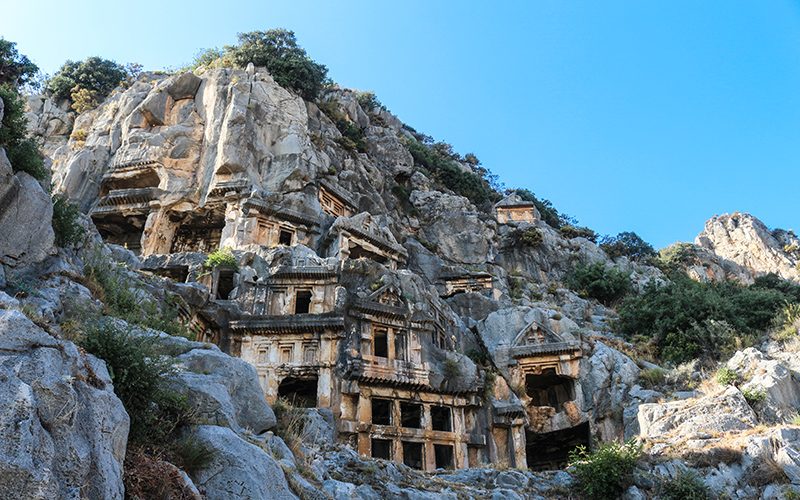The Ancient City of Myra, located in Antalya’s Demre County, is one of the Lycian Civilization’s most special settlements. Located at the crossroads of maritime and land-based trade routes, Myra is located in the central Lycian region and served as the most important agent of Lycian art and culture.
One of the most touristic ancient cities on the Mediterranean coast, Myra impresses with its theater, Byzantine-period St. Nicolas (Santa Claus) Church, and rock-cut tombs. Located near the center of Demre, the ancient city of Myra was built above the plains of the same name. Found on the Teke Peninsula, the city is two kilometers from the center of Demre.

The city was connected to the sea by way of a channel to the west of the Myros River, now known as the Demre Stream. The Andriake (Cayagzi) Harbor, located on the other side of the channel, was used for maritime transport and trade in the region.
The Ancient City of Myra
Demre is one of the 19 counties of Antalya. It’s located 145 km from the city of Antalya. It’s one of the two westernmost counties, with only Kas found farther west. With its nature, history, and culture, Demre is one of the most special settlements on the Mediterranean coast. Its old name is Kale (meaning castle or fortress).
The first thing that comes to mind when you say Demre is definitely the ancient city of Myra. Myra is the best-known site in Demre. The ancient city is one of the six biggest cities in the Lycian Civilization, which was home to the earliest known federation. The name ‘Myra’ means ‘the city of the almighty mother goddess’. According to Strabon’s records, Myra was recorded as Myrrh on Lycian inscriptions.
The head of excavations of Myra, Prof. Dr. Nevzat Cevik, notes that Myra’s first name was Muri. The pronunciation of the name Muri changed to Myra over time. In his book Geographika, Strabon wrote that Myra was one of the 23 cities with the right to vote. Of these 23 cities, the biggest were given three votes, medium-sized cities two, and small cities one. The six biggest cities with three votes were Xanthos, Patara, Pinara, Olimpos, Tlos, and Myra.

Easily reached from the city center, the ancient city of Myra is perched just in front of a high hill. Myra is surrounded by mountains on three sides. The rock tombs to the left of the entrance are impressive and the large theater to the right rises from the ground in all its glory. Each of the rock tombs, seemingly fastened to the cliff-face, are their own carefully crafted works of art. Laws regarding the protection of these tombs and a separate government organization called ‘minti’ were even developed.
It seems like there is no other Anatolian civilization that placed as much importance on their tombs as the Lycians. They’ve created a barrier of chains in front of the tombs for their protection, you can’t get too close. But don’t forget to take a picture with these tombs behind you.
The ancient theater is just a few meters from the tombs. Take the stairs up to the top of the theater to see the stage from above. The solid, intact theater looks like it was built yesterday. The steps, seats, stage, and stone walls managed to survive to our modern day.
The story of this ancient city is also interesting. Its rock tombs, Lycian inscriptions, and coins indicate that Myra has been around since at least the 5th century BCE. The coins minted during that period feature a relief of the mother goddess (Artemis). However, the ancient city of Myra didn’t begin to play an active role in history until the Hellenistic Period.
Myra underwent a period of development in the 2nd century BCE. Myra experienced a breakthrough during this century and was furnished with many buildings. In this city, a metropolis of the Lycian Civilization, many buildings were constructed and repaired with the help of the wealthy citizens of Lycia.
During the Byzantine Period, Myra became as much of an administrative as a religious city. It derives most of its fame that still exists today from St. Nicolas (Santa Claus), who was the city’s bishop in the 4th century and the church constructed here in his honor after he died and became a saint. The city where St. Nicolas served as bishop was well-known in the Middle Ages.

In the 7th century, Myra was destroyed by earthquakes and floods. It was damaged and weakened due to the silt brought by the Demre Stream and the Arab invasions and its commercial importance began to fade. By the 13th century, the Demre Stream had filled the plains with up to nine meters of silt. Today’s city of Demre sits on top of this silt. Who knows what is lurking underground?
How to Get to the Ancient City of Myra
Myra is located between Kas and Finike. The ancient city is 30 km from Finike, 45 km from Kas, and 20 km from Kekova (Ucagiz Village). Therefore, it is located on the route of many visitors to the region and is easily accessible. If you plan to visit Adrasan or Kas, add the ancient city of Myra and the St. Nicolas Church in Demre to your travel plans.

